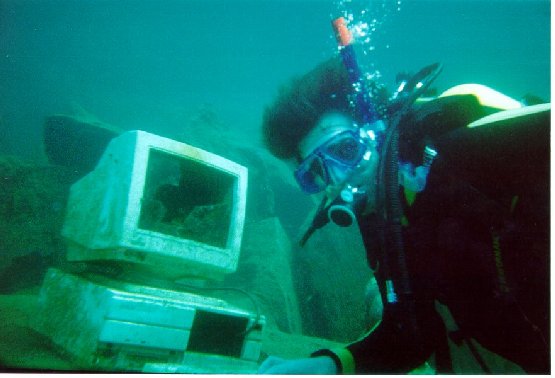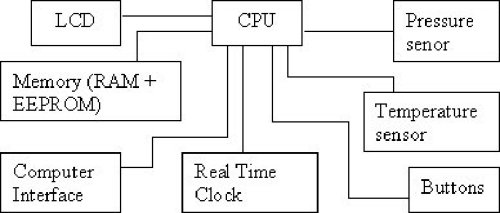Introduction
- Who am I
- Diving experience
- You ain't from around here boy!
- Stop me if you can't understand
- Ask questions any time
What is this all about

- Dive Computers
- Decompression theory
Decompression theory
- How nitrogen dissolves in your tissues
- Henry's law
- What is saturation
- Why saturation depends on depth and dive time
- What happens when you go deeper - suprasaturation
- What happens when you ascend.
- Tissues and tissues compartments
- Why bubbles form - microbubbles
- Why do bubbles cause pain or paralysis
How tissues compartments may connect
- Haldane model - parallel model
- Series model - DCIEM tables (Canada)
- Exponential linear - ongass exponential (fast), ofgass linear (slow)
- Slab - only one compartment (British Sub Aqua Club tables)
- Buhlmann model - parallel series
Haldane's model
- J.S Haldane created his theory in the early 1900
- Tissues half-live theory – how tissues accumulate and release nitrogen
- Tissue half-live – the time necessary to allow the amount of gas to change by 50%
- Haldane chose 5, 10, 20, 40 and 75 minutes as tissue times (limited by the technology)
Buhlmann's model
- Developed by Albert Buhlmann over 30 years and published in 1983
- More tissue compartments that Haldane
- Tissues are parallel series tissues
- The most used in the current computers
- Full specifications of the decompression algorithm published
History of dive computers
- First serious attempt to make a decompression meter done by the US Navy in the mid fifties
- First decompression meter available to the public – Italy 1959
- First commercially available (electronic) dive computer – Orca Edge 1983 based on the Haldanian decompression theory
Dive computers explained
- Electronic devices that compute in real time your theoretical nitrogen level
- Component parts:
- The case
- The pressure sensor
- The O-rings
- The PCB
PCB - component blocks

Features of dive computers
- User replaceable batteries
- Sturdy housing
- Large displays
- Color coded readings
- Decompression algorithm range appropriate to your dive profile
- PC downloadable
- Auto-activation
- Backlighting
- Audible warnings
- Altitude algorithms
- Multiple tissue compartment models
-
Individual coded transmitters for hoseless air integrated computers
The new Uwatec computers
- Maximum displayed depth 120 m
- Resolution between 0.8 m and 99.9 m: 0.1 m, >99.9 m: 1m. The resolution in feet is always 1 foot
- Calibration in fresh water.
- Adaptive Buhlmann decompression algorithm with 8 tissues (ZH-L8 ADT)
- Microbubbles compensation (6 microbubble levels)
- Algorithm adjust for the workload, altitude (automatic) and temperature
- Display water temperature and ambient temperature
- User adjustable tank reserve setting
- Factory replaceable battery. Life 5 years (500 - 1000 dives).
- Nitrox capable. Oxygen mix adjustable in 1% increments.
- Dives stored in the dive log: 99 logged dives.
- Dive profile: 100 hours (smart pro), 50 hours (smart com).
- Variable ascent rate.
- Wet fingers contacts user interface
- Auto switch on.
-
IrDA PC communication
Dacor Darwin Computer
- Maximum displayed depth: 150 m.
- Measurement resolution: 10 cm in the 0-100 m range / 1 m in the 100-150 m range.
- Temperature compensation of the measurement.
- Calibration in fresh water.
- Algorithm: Deterministic-exponential algorithm, with M values (low bubble) derived from the Rogers methods (modified Haldanean).
- 11 tissues.
- Power supply: 2 alkaline 1.5 V batteries (type AAA) user replaceable. Life: 12 months with 50 dives
- Nitrox capable. Oxygen mix adjustable in 1% increments
- Manual adjustment for altitude.
- Manual selection of fresh/sea water.
- Manual clear of residual nitrogen.
- Dive history: deepest dive, total number of dives, coldest temperature, total dive time.
- Dives stored in logbook: 50 with profile for a maximum of approximately 38 hours.
- Dive profile sampling interval 20s.
- Buttons user interface
- Button switch on before dive recommended but not required.
- PC interface
Dacor Transcend Computer
- Maximum displayed depth 99 m.
- Modified Buhlmann algorithm, with EAN calculation for enriched air Nitrox dives and J correction factors for personalized algorithm.
- Display user configurable.
- Backlight changes color.
- Nitrox capable
- Manual clear of residual nitrogen.
- Battery replaceable by user 2 years operation.
- Dive profile intervals configurable by the user (20s/30s/60s)
- Memory capacity for 100 one-hour dives with 20 sec profile intervals.
- Wet fingers contacts user interface
- 5 manual altitude programs.
- Manual water salinity correction factor (0%, 1%, 5%).
- PC interface.
Conclusion
- Things to remember:
- Diving with a computer makes your dive safer although DCS can still occur
- Remember that the decompression model is a theoretical one
- Read your computer manual and KNOW your computer
- Follow what your computer is telling you to do
- Check your batteries and don’t ignore the low battery warning